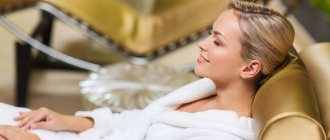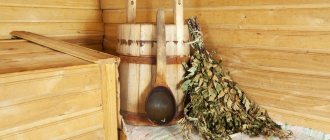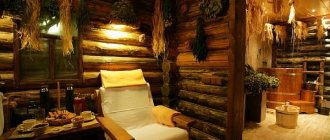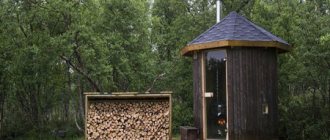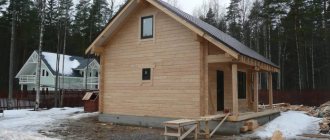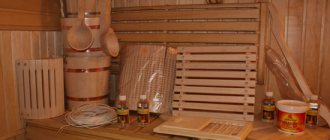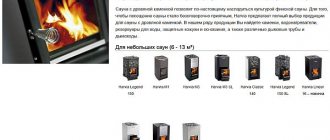Fire safety of the bathhouse
I am glad to welcome dear reader! Today we’ll talk about safety in our bathhouse...
Any high-power heating device is inherently a fire hazard. We use a stove for heating in every bathhouse. It doesn’t matter which one - gas, wood or electric. Each steam room in this case becomes an object of increased fire danger.
Therefore, in this important topic, it is imperative to adhere to certain rules. And failure to comply with them can lead to very sad consequences.
The fire safety of the bathhouse should be thought out at the very initial stage of construction. But if any mistakes have already been made, they should be eliminated as quickly as possible. A lot depends on this...
Fire safety standards for the construction of a bathhouse
Fire standards are taken from sections of GOSTs, compared with the classification of saunas/baths by flammability. Apply:
- by buildings:
- SNiP 31-05-2003 (SP 117.13330.2011) (clause 6.3.9), 2.09.04-87 (SP 44.13330.2011) (clauses 2.34, 2.35, 2.36);
SP 118.13330.2012 (SNiP 31-06-2009), 53.13330.2011, 54.13330.2016, 55.13330.2016 (SNiP 31-02-2001);
- general rules:
- SNiP 21-01-97 aka SP 112.13330.2011 – PB classes;
NPB 110-03, 88-2001;
- Federal Law 123 – technical regulations, fire resistance limits, fire safety classes;
- projects, planning, placement:
- SP 11.106-97, 4.13130, 60.13330 (SNiP 41-01-2003);
- equipment:
- SP 7.13130;
Rules for electrical installations;
- "Methodological recommendations for the design of baths...".
Baths are built only according to pre-agreed projects according to SP 11.106-97.
Bathhouse: functional fire hazard class
According to PB standards and clause 5.21 of SNiP 01/21/97, baths, saunas, health institutions, sports and training institutions without stands, and household facilities are assigned class F3.6.
PB of a free-standing bathhouse
Fire resistance level of the sauna building:
- fire resistance – not lower than III;
- for 20 places and less – IV – V.
Fire safety requirements for room parameters:
- steam room:
- volume – from 8 m³, but not more than 24 m³;
in height - not less than 1.9 m;
- up to 2 floors;
- separate exit;
- supply and exhaust ventilation;
- gap under the door – from 30 mm;
- compliance with the location in relation to neighboring buildings, from the fence to the bathhouse.
PB saunas inside the house
Safety for placing built-in saunas:
- in objects of I – III degrees of classes C0 and C1 the following are distinguished:
- fire-resistant barriers of type I with resistance limit REI-45;
type III covering elements, REI-45;
- in buildings of IV degree, C0 - C3 - with the indicated structures REI 60;
- a separate exit for evacuation, not combined with other passages;
- seats in the sauna steam room - up to 10 people.
According to fire safety standards, built-in dry baths (saunas) are prohibited in:
- basements (ground floors);
- adjacent (above and below) to objects where more than 100 people stay. or to the living rooms of neighboring apartments;
- in dormitory buildings;
- under the stands.
The restrictions do not apply to establishments put into operation before the adoption of these changes, and the infrared sauna also circumvents the prohibitions.
Distance from the house to the bathhouse according to fire safety
Fire regulations for placement:
- distance between house and bathhouse on one site:
- brick sauna with a non-combustible roof - 8 m from the same building, if the second building with a combustible roof - 10 m;
if the roof of a brick bathhouse is fire hazardous - 10 m;
- both buildings are made of wood - 10 m, if more than 1 floor - 15 m;
- to a neighboring house on a different site from the fence (distance to the border, but the total distance is as indicated above):
- without sewerage – 3 m;
with drainage, drain – 1 m;
- distance from the bathhouse to the bathhouse of the neighboring plot. Distance standards - 10 - 15 m (wooden) and 6 m (brick) - from table. 11 Federal Law 123 is outdated, therefore the rules of the previous paragraphs apply.
Fireproof materials
Fire resistance limits for sauna materials:
- degree – I – III;
- fire hazard of load-bearing elements – C0 and C1;
- fire resistance limit of materials EI-45, EI-60.
Fire safety methods and materials for saunas are usually structural:
- partitions – I, ceilings – III type of fire resistance. It is allowed to use plastic glass blocks;
- fire-retarding valves in ventilation;
- fireproof insulation for all heating elements, chimney: basalt, mineral wool;
- setback, fire gap - the distance between devices and walls;
- cuttings - filled/made indentations (with brick, vermiculite, etc.);
- aprons;
- cladding
Wooden bath structures can be protected with impregnations, but only with special (non-toxic) impregnations intended for objects of this type, preferably antiseptic (against rotting), OE group 1. Deep processing technology is recommended.
The compositions should be used only in certain places, since the OS minimizes the smell of natural wood, as well as for elements that are not in contact with the human body (not in the steam room, near stoves, remote places).
Electrical requirements
In steam rooms, the use of electric furnaces is common. The premises also have wiring for lighting fixtures. Requirements:
- compliance with the PUE;
- reliability of power supply:
- Category 2 – from 100 places;
Category 3 – up to 100 places;
- cable entries made of asbestos-cement pipes from 100 mm with a slope from the building;
- all cables are heat-resistant;
- switches in wet rooms are not allowed;
- wires for maximum room temperature;
- do not place input distribution units, switches under steam rooms, bathing rooms, or other wet places;
- lamps in wet and humid conditions are protected by heat-resistant glass and mesh;
- internal wiring:
- aluminum;
in steam rooms - copper with heat-resistant insulation;
- open, pipeless (attached with staples to the surface) with asbestos cord winding;
- protective grounding.
No short circuits
From the point of view of the “Rules for the Construction of Electrical Installations” (PUE), bathhouses with their excessively humid climate are extremely dangerous premises, since moisture and electricity are bad “friends,” especially in conditions of high temperatures and the presence of metal conductive objects (cases, screens, trays, etc.) etc.). Therefore, the rules require especially careful installation and operation of electrical wiring in order to protect people from possible electric shock and prevent the occurrence of a fatal spark that triggers the fire element.
In wet and very humid rooms, the PUE is required to use hidden electrical wiring, and laying wires with metal sheaths, in metal pipes and metal hoses is not allowed - due to possible corrosion of the sheath. However, unlike public baths, where “sessions” follow each other continuously, in individual steam rooms the duration of hygienic procedures is relatively short, so the threat of corrosion of steel pipes is minimal. In addition, high temperatures soften the plastic insulation of the wires, as well as evaporate the plasticizer, which leads to hardening of the insulating coating of the wires and increases their fragility.
Therefore, both metal and plastic sleeves are used for electrical wires, depending on the specific conditions. When installing internal wiring in combustible walls, the cable is placed in a metal pipe, and in fireproof and fire-resistant walls, the use of both metal hoses and plastic pipes is allowed. In the latter case, the thermal resistance of the insulation must be increased, designed for the maximum permissible temperature.
And yet, the optimal choice is thick-walled steel pipes, which reliably prevent fire in the event of a short circuit. The pipe is thrown as high as possible (so that it is impossible to touch it with your hand, even by accident) and grounded to a solidly grounded neutral with a separate wire with a cross-section of at least 1.5 mm2 using a grounding bolt welded to the pipe.
Protective grounding consists in the fact that all metal casings of electrical devices, pipes, cladding sheets are interconnected and connected to the neutral wire of the electrical network. This will protect a person from electric shock when contacting the metal surfaces of housings and pipes, but naturally it will not save a person from touching exposed phase network wires. Of course, you can use low voltage to power the entire bathhouse (AC 42 V or DC no more than 110 V), then accidental contact will be safe. This requires a rechargeable battery or a step-down transformer. The second option is less safe, since in an emergency there is still a possibility of phase potential reaching the step-down winding of the transformer.
An automatic switch is installed on the phase wire of the bathhouse electrical network, which is triggered at a current value of no more than 16 amperes (experts recommend installing the same on the neutral wire). This is a completely effective fire safety measure. If for any reason (for example, an insulation failure occurred that caused the wires to contact) a short circuit occurs, the circuit breaker will cut off the current, stop the arcing and prevent a fire.
How to protect a bathhouse from fire from the stove
Heating options for saunas:
- brick or metal wood stove;
- electric furnaces (electric heaters).
Wood-burning stove equipment according to SP 60.13330.2012 is permissible only for one-story bathhouses with seats for up to 25 people. Ways to protect a sauna from fire from the stove: cladding, casings, lining, offsets, cuts.
What are the dangers of stoves:
- dumping burning particles;
- release from the firebox and body, especially in case of emergency damage (hull burnout / masonry cracks):
- sparks;
flame;
- hard to detect cracks;
- heating of surrounding elements (floor, ceiling, walls) by the furnace body.
How to cover/cover a stove
Enhanced fire safety measures for heating equipment:
- screens for sauna stoves (casings):
- brick, metal;
corrugated roofing materials;
- plaster 25 mm on an iron mesh chain-link or on asbestos with a thickness of 8 - 10 mm;
- lining (cladding) is required when heating with a metal stove:
- the floor in front of the door is covered with a steel sheet of 50x70 cm. In a long line along the stove. Around there is a steel sheet on asbestos cardboard 150 mm larger than the dimensions of the body;
podium and apron: brick, concrete, ceramic (tiles), asbestos and iron;
- for walls: fire-retardant boards, mineral insulation with a metal base or brick;
- non-combustible floor - higher from the main one;
- fire distances from the stove (setback):
- to combustible floors without protection - from 210 mm (air or brick), with protection - from 100 mm;
to the walls - no less than 200 mm;
- from the ceiling at least 1200 mm, always with a fire-resistant sheet;
- fencing:
- there is a shield under the ceiling (5 cm from the surface);
cases (metal covers) against spilling of fuel, sparks, flames;
- cuttings for brick chimneys – from 500 mm.
Temperature for stoves according to NPB (can only be observed if shielded):
- +120°С for the body;
- +80°C for walls;
- below +50°C.
The standards are not always the same, so they are also guided by:
- manufacturer's instructions;
- engineering considerations;
- recommended materials.
The temperature in places where the stove comes into contact with flammable objects should not exceed +50°C.
How to secure a chimney pipe
Chimney fire protection:
- fencing:
- shielding of walls (metal sheet), one sandwich pipe is not enough;
passage box with backfill;
- interfloor divisions are mandatory;
- the brick pipe is coated with clay and whitened to visually detect cracks and soot;
- at least 380 mm to combustible structures (rafters, roof sheathing);
- chimney cutting:
- interfloor vertical mandatory: height from 70 cm, thickness from 12 cm, for temperatures from 100°C - 25 cm;
desirable horizontal (brickwork) for the attic;
- thermal insulation along the entire length;
- inspection hatches;
- you cannot connect 2 stoves simultaneously to one chimney pipe;
- regular cleaning and inspection.
Danger of chimneys:
- holes become clogged;
- risk of burnout, cracks;
- heating of surrounding elements;
- soot accumulation: a layer of 2 – 3 mm is fire hazardous.
PB requirements for the installation of electric furnaces
Standards on how to protect a bathhouse from fire when using an electric heater:
- power exactly according to the parameters of the sauna, but up to 15 kW;
- self-shutdown after 8 hours of operation;
- control unit in a dry place in front of the steam room;
- all cables are fireproof insulated;
- wiring to the control cabinet:
- copper;
in steel pipes in concrete floor preparation;
- potential equalization grid;
- the distance to the walls is up to 20 cm, under the ceiling above the device there is a heat-insulating shield with a distance to the casing of at least 5 cm.
- in automatic mode, the temperature in the steam room is up to +110°C, automatic shutdown at +130°C.
Operation phase
When all construction aspects are completed, you can enjoy the result. To make it long and safe, follow 6 simple rules:
- Do not use gasoline or flammable liquids for ignition. Choose newspapers and dry firewood.
- Do not bring it to the maximum temperature - 110 ° C, otherwise the wood will begin to smolder.
- Clean the chimney regularly to remove soot.
- Monitor the condition of the masonry stove chimney and wiring of the electric stove; if cracks or malfunctions are detected, do not delay repairs.
- Do not leave the sauna firebox unattended.
- Do not drink alcohol, do not smoke, and do not dry clothes over the stove.
A bonus for those who read to the end is a clear infographic to make it easy to remember.
Fire extinguishing agents in saunas and baths
For private steam rooms there are no requirements for alarms or extinguishing installations. But, if this is a public, commercial building, then it is necessary to protect the bathhouse from fire with extinguishing and notification systems.
Which fire extinguisher is better
Features of fire extinguishers:
- – effective, but there is a risk of carbon dioxide poisoning (requires special protection), do not wet, cold burns are possible;
- , ORP - ends quickly, with a weak stream;
- – universal, create a non-flammable layer of powder;
- OVE - effective, harmless.
{banner_downtext} For baths, air-emulsion fire extinguishers are recommended, preferably from 8 liters, and powder ones, especially for objects with an electric heater, since the extinguishing agent does not conduct electricity.
Fire extinguishing systems
Steam rooms in public and commercial establishments must be equipped with automatic deluge fire extinguishing systems:
- dry pipe;
- source - internal water supply;
- automatic and manual start simultaneously;
- remote control, valve in a separate room nearby or in front of the entrance.
Sometimes sprinklers are installed, but with activation from +125°C, and there is logic in this, since the need to open doors, leading to a flame explosion, is reduced. Foam and water installations (drenchers, sprinklers, expansion valves) are standard for saunas.
Do you need a fire alarm in a bathhouse?
The instructions on safety measures do not contain requirements for the presence of fire alarms in private baths, but the equipment is mandatory for public and commercial establishments.
According to NPB 110-03, a sauna is a building for public, domestic purposes and must be equipped with automatic alarms, except for wet rooms (steam rooms, showers, sinks).
Sensors, detectors
In locker rooms, dressing rooms, and auxiliary parts (not wet), heat fire detectors and smoke detectors must be installed. In wet rooms (steam rooms), sensors are installed less frequently or are not used, but they are not prohibited. There are special devices for baths, for example, IP 105-1 G “Sauna-150” with activation at +110°C.
Preventive measures
To increase the fire resistance of wood, it is treated with special impregnations that prevent combustion - fire retardants. The principle of operation of such products is either the melting of special substances included in their composition (salts of boric, phosphoric or silicic acids), or the release of gases that impede the combustion process (ammonia, sulfur dioxide). In the first case, a film shell is formed on the surface of the wood, limiting the access of oxygen. The result is an increase in ignition temperature. In the second case, non-flammable gases released during the decomposition of salts displace oxygen from the surface, interfering with combustion and slowing down the spread of the flame.
Depending on the composition, fire-fighting agents either prevent the spread of flame (group II of impregnations, the purpose is to ensure that wood is difficult to ignite), or provide comprehensive protection (group I - making the material difficult to burn). At the same time, the actual purpose of treatment with fire retardant compounds is not fire protection as such (it is clear that once a fire has started, impregnations cannot stop it). But they will give people time - because sometimes even 20-30 minutes are absolutely necessary in order to have time to take some action or simply leave the building.
Products applied to the surface require regular updating at certain intervals. The so-called deep impregnation, which is produced in an autoclave using the “vacuum-pressure-vacuum” technology, is more durable. It provides fire and bioprotection for the entire life of the structure. Wood after such treatment becomes difficult to burn (in the flame it does not burn, but smolders, and after the source of fire is removed, the smoldering stops).
The vast majority of products on the market today are combined, they are designed to solve not only fire protection, but also bioprotective problems, as well as issues of climate resistance.
Text: Vladimir Breus
